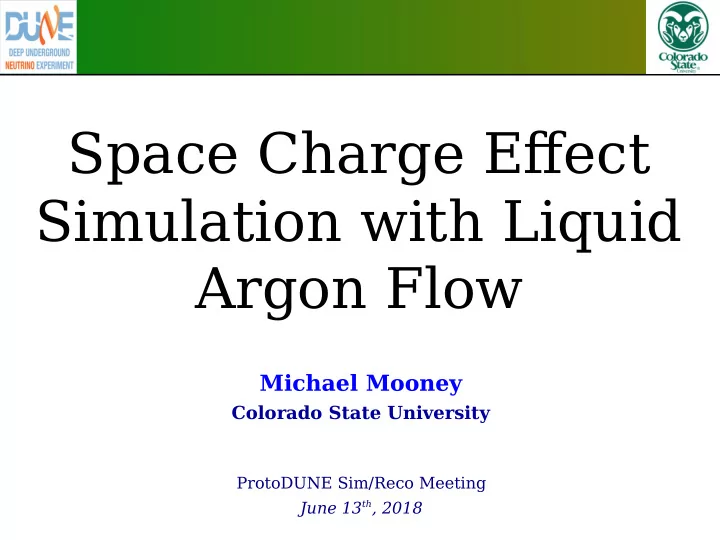

Space Charge Efgect Simulation with Liquid Argon Flow Michael Mooney Colorado State University ProtoDUNE Sim/Reco Meeting June 13 th , 2018
Introduction Introduction ♦ Expect space charge efgects (SCE) to be one of two leading detector efgects at ProtoDUNE-SP • The other: ADC issues (stuck codes, nonlinearity) • Important focus of calibration studies prior to fjrst operations of detector ♦ Open question: how much do we expect fmow of liquid argon to impact underlying space charge confjguration? • Ion drift velocity in electric fjeld and expected liquid argon fmow velocity are similar in magnitude • Could lead to build-up of space charge in certain parts of detector, or at least modify space charge distribution ♦ Today: show fjrst study of LAr fmow on SCE 2
Fluid Flow Simulation Fluid Flow Simulation ♦ Developed by Erik Voirin for ProtoDUNE-SP (previously produced for 35-ton) – see DUNE Doc DB #928 ♦ 3D simulation of LAr fmow, 8 mm/s ion drift @ 500 V/cm, uniform space charge deposition from cosmics ♦ Ion absorption at fjeld cage, APA, CPA, and all solid objects inside cryostat – see Erik’s talk for more info 3
SCE Simulation SCE Simulation ♦ Make use of code suite developed by M. Mooney for simulation of SCE given space charge density map from Erik’s simulation • SpaCE – Space Charge Estimator ♦ Fourier series solution for electric fjeld on grid, radial basis functions for interpolation of fjeld between grid points, and ray tracing based on RK45 for determining spatial displacements due to SCE ♦ Nominally assumes linear space charge distribution (zero at anodes, maximal at cathode), but code suite has capability of using arbitrary space charge distribution as input • Compare nominal SCE maps to ones including LAr fmow 4
Data/MC Comp. @ μ μBooNE BooNE Data/MC Comp. @ ♦ Transverse spatial distortions (TPC top/bottom) observed in data ~reproduced with SCE simulation • MicroBooNE Public Note: MICROBOONE-NOTE-1018-PUB • Asymmetry in data (not predicted in simulation): smaller distortions at TPC top (see later slides!) 5
Spatial Ofgsets: Z = 0.6 m Spatial Ofgsets: Z = 0.6 m 6
Vs. No Flow: Z = 0.6 m Vs. No Flow: Z = 0.6 m 7
Spatial Ofgsets: Z = 1.6 m Spatial Ofgsets: Z = 1.6 m 8
Vs. No Flow: Z = 1.6 m Vs. No Flow: Z = 1.6 m 9
Spatial Ofgsets: Z = 2.6 m Spatial Ofgsets: Z = 2.6 m 10
Vs. No Flow: Z = 2.6 m Vs. No Flow: Z = 2.6 m 11
Spatial Ofgsets: Z = 3.6 m Spatial Ofgsets: Z = 3.6 m 12
Vs. No Flow: Z = 3.6 m Vs. No Flow: Z = 3.6 m 13
Spatial Ofgsets: Z = 4.6 m Spatial Ofgsets: Z = 4.6 m 14
Vs. No Flow: Z = 4.6 m Vs. No Flow: Z = 4.6 m 15
Spatial Ofgsets: Z = 5.6 m Spatial Ofgsets: Z = 5.6 m 16
Vs. No Flow: Z = 5.6 m Vs. No Flow: Z = 5.6 m 17
Spatial Ofgsets: Z = 6.6 m Spatial Ofgsets: Z = 6.6 m 18
Vs. No Flow: Z = 6.6 m Vs. No Flow: Z = 6.6 m 19
Discussion Discussion ♦ Main efgects of liquid argon fmow on SCE: • Magnitude of distortions roughly 2/3 in comparison to nominal case (no fmow) – Ion deposition rate used by M. Mooney and Erik are almost identical: ~ 2×10 -10 C/m 3 /s • Very difgerent distributions in the two drift volumes • SCE smaller at top of TPC (also seen at MicroBooNE) ♦ Distributions still smoothly vary across drift volumes, as in nominal case ♦ Noteworthy: no large build-up of space charge predicted in any one place when including efgects of fmuid fmow ♦ Useful case study for qualitative understanding, but may be very difgerent in reality • Essential to have data-driven calibration 20
BACKUP SLIDES
Half Field Ofgsets: Z = 3.6 m Half Field Ofgsets: Z = 3.6 m 22
Half Field Vs. No Flow: Z = 3.6 m Half Field Vs. No Flow: Z = 3.6 m 23
Space Charge Efgects Space Charge Efgects ♦ Space charge efgects: build-up of slow-moving argon ions in TPC volume due to large cosmic fmux (affmicting near-surface LArTPCs, e.g. ProtoDUNEs) • Observed at MicroBooNE: MICROBOONE-NOTE-1018-PUB • Distorts E fjeld (recombination smearing), leads to spatial distortions in position of reconstructed ionization charge 24
SCE Predictions SCE Predictions ProtoDUNE ProtoDUNE SP DP DUNE SP DUNE DP Far Detector Far Detector 25
ProtoDUNE-SP @ 250 V/cm? ProtoDUNE-SP @ 250 V/cm? 500 V/cm 250 V/cm ~20 cm ~60 cm spatial spatial distortions distortions 26
SCE w/ Fluid Flow (35 ton) SCE w/ Fluid Flow (35 ton) 27
CRT Layout CRT Layout 28
Using Muon Halo Using Muon Halo y Muon Halo Coverage Map (ProtoDUNE-SP TDR) units: μ/m 2 /spill (spill length: 4.8 s) x ♦ Muon halo can fjll in gap (active volume in red, above) ♦ However, relative to cosmics, rate is low: O(100)/spill ♦ Need CRT triggers to save as many as possible 29
Other t 0 -tagging Methods Other t 0 -tagging Methods Cathode- Anode- Piercers Piercers ♦ What about using other t 0 -tagging methods to fjll gaps? ♦ For example, MicroBooNE’s anode/cathode piercers: • See public note: MICROBOONE-NOTE-1028-PUB ♦ But this sample still sees a gap in the middle of TPC... 30
Recommend
More recommend